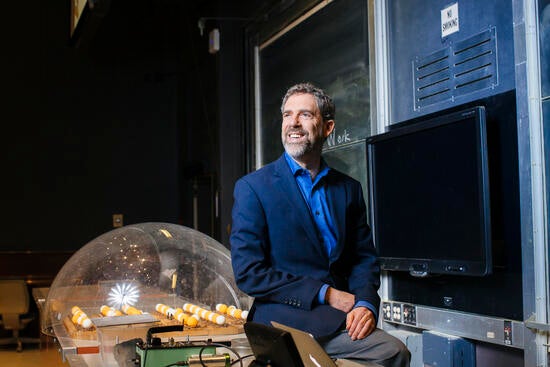Kenneth Barish, a professor of physics and astronomy, has received a three-year renewal grant of more than $1 million from the Department of Energy, or DOE, to support the activities of the Nucleon Spin Physics Group at UC Riverside. The group’s research aims to unlock secrets about the fundamental structure of the universe by probing the internal structure of nuclei and understanding why the constituents of the proton are confined and where the proton’s spin originates.

The grant renewal will support the work of three graduate students, David Kapukchyan, Xilin Liang, and Ananya Paul, as well as a postdoctoral researcher, Weibin Zhang. The grant will also cover Barish’s summer salary and travel related to activities at the Relativistic Heavy Ion Collider, or RHIC, at Brookhaven National Laboratory in Upton, New York.
“We outline a three-year plan to investigate the nucleon’s spin structure,” Barish said. A nucleon refers to either the proton or the neutron, the building blocks of atomic nuclei. “The importance of gluons within protons and neutrons has become increasingly apparent as precision measurements of quarks’ role within the nucleons have revealed unanswered questions. The RHIC spin program, and ultimately the Electron-Ion Collider, will complete the picture with precision measurements of gluons within the nucleons.”
Quarks and gluons are fundamental particles that make up protons and neutrons. Spin, which is a fundamental quantum number, is an intrinsic form of angular momentum carried by elementary particles.
RHIC is an accelerator designed to collide intersecting beams of heavy ions in the search for a state of matter called quark-gluon plasma. At RHIC, two primary research focuses are polarized proton collisions and heavy ion collisions. The facility consists of two accelerator rings, each measuring 2.4 miles in circumference, equipped with hundreds of superconducting magnets. These magnets guide gold nuclei around the rings at speeds approaching that of light, resulting in extremely high energy levels for the nuclei.
The Electron-Ion Collider, or EIC, is a planned major new nuclear physics research facility at Brookhaven National Lab that will explore mysteries of the “strong force” that binds the atomic nucleus together. Electrons and ions, sped up to almost the speed of light, will collide with one another in the EIC.
The Nucleon Spin Physics Group at UCR focuses on the transverse spin and helicity structure of the proton. Transverse refers to a direction of motion — specifically, the direction perpendicular to an object’s motion. A proton’s transverse properties in spin and motion can give physicists valuable information.
“We’re working to uncover the internal structure of protons, which is still not fully understood in terms of how it contributes to their properties,” Barish said. “Specifically, we want to explore how quarks and gluons combine to create the proton’s mass. Our experiments aim to shed light on these important questions.”